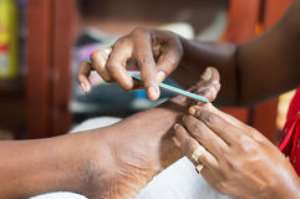
Pre-screen your salon
Podiatrist Joy Rowland, DPM , tells her patients to scope out the pedicure salon first. It’s important to make sure instruments used on your feet are sterilized. Foot baths or bowls should be cleaned with hospital-grade disinfectant between clients, she says.
“Visit the place you want to go,” Dr. Rowland says. “As you’re in the waiting room, watch and see what they do. Make sure they bring out new instruments for each client and clean and disinfect their bowls after each use.”
If you can’t tell, Dr. Rowland says don’t be shy to ask about cleaning procedures. Make sure the salon uses a process called autoclaving, which is the method hospitals use for sterilizing surgical tools. If they do, you’re good to go, Dr. Rowland says.
It’s also important that the salon technicians don’t tear or cut your skin with the tools they use during a pedicure, Dr. Rowland says. Microorganisms in foot bowls can enter through a cut and cause an infection. So don’t ever put an open wound, which can include bug bites, scratches and cuts, into a foot bath.
“Sometimes the skin gets cut during the pedicure, then they put their feet inside the bowls. The bacteria from the legs, which is the natural flora from the skin, is swirling around inside the bowl and gets inside the cut. This can cause an infection inside the skin,” Dr. Rowland says.
The right tools and methods
It’s a good idea to ask the salon technician to avoid cutting your toenails too short, Dr. Rowland says. When a toenail is too short, it can result in an ingrown toenail or an infection.
Some salons use tools that look like cheese graters or metal files to remove dead, dry skin and calluses, but it’s best to avoid using rough instruments on your skin, Dr. Rowland says. Tools that look like sandpaper or brushes are softer on the skin, so ask for those at the salon instead.
“I do not recommend metal files,” she says. “I even tell my patients when they’re in the office that if they file their own calluses at home to please not use metal files because they can tear the skin.”
When pedicures go bad
If pedicure tools aren’t sterilized properly you can get skin and nail infections, which may show up immediately or later — even months later. These include:
- Bacterial infections. If your toenail or area around the nail appears red, hot or swollen a few days after your pedicure, you may have a bacterial skin or nail infection. Treatment can include antibiotics and possibly an incision to drain the area.
- Fungal infections. Your nail turning yellow and beginning to lift off is a sign of a nail fungus, one of the most common results of a rogue pedicure. Fungal infections may not appear for months. Oral and topical treatments can resolve these infections.
- Viral infections. These come in the form of plantar warts, the most common viral infection of the foot, and these too may not show up for months after the pedicure. You can pick these up in the salon or spa or neighborhood pool. Dark spots and a callus-like covering are common with plantar warts. Treatment for these include medicine that applied to the skin.




 Ghana will make maiden voyage into space should Bawumia become President — Chair...
Ghana will make maiden voyage into space should Bawumia become President — Chair...
 Train crash: Despite the sabotage, we shall not be deterred and will persevere —...
Train crash: Despite the sabotage, we shall not be deterred and will persevere —...
 Tema-Mpakadan railway project a perversion of the original viable concept design...
Tema-Mpakadan railway project a perversion of the original viable concept design...
 Train crash: Elsewhere, everyone involved in the test will either be fired or re...
Train crash: Elsewhere, everyone involved in the test will either be fired or re...
 Ghana, other election bound-countries must build fiscal buffers – IMF admonishes
Ghana, other election bound-countries must build fiscal buffers – IMF admonishes
 Parliament reconvenes late May, denies Speaker Bagbin delaying recall over NDC t...
Parliament reconvenes late May, denies Speaker Bagbin delaying recall over NDC t...
 $100m needed to revitalise Ghana's poultry sector — GNAPF
$100m needed to revitalise Ghana's poultry sector — GNAPF
 Driver arrested for causing train collision on Tema-Mpakadan Railway Line
Driver arrested for causing train collision on Tema-Mpakadan Railway Line
 Police grab trucker for Tema-Mpakadan rail accident
Police grab trucker for Tema-Mpakadan rail accident
 Gov't plans to revise traditional customs following Gborbu child marriage
Gov't plans to revise traditional customs following Gborbu child marriage
